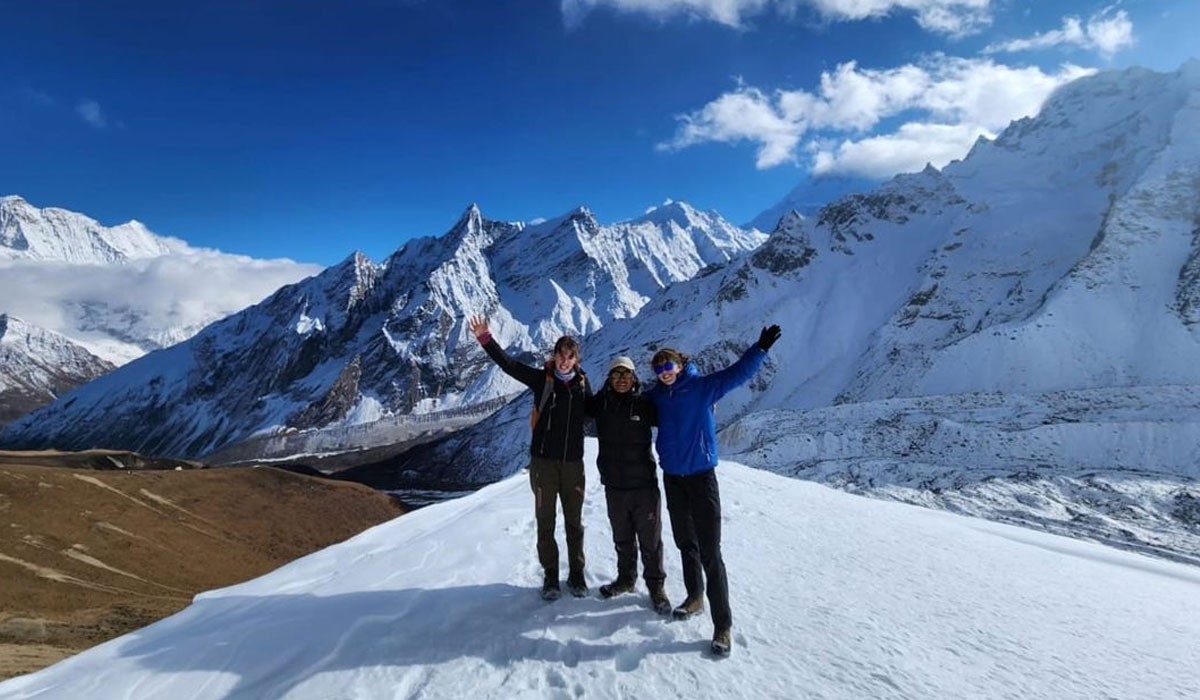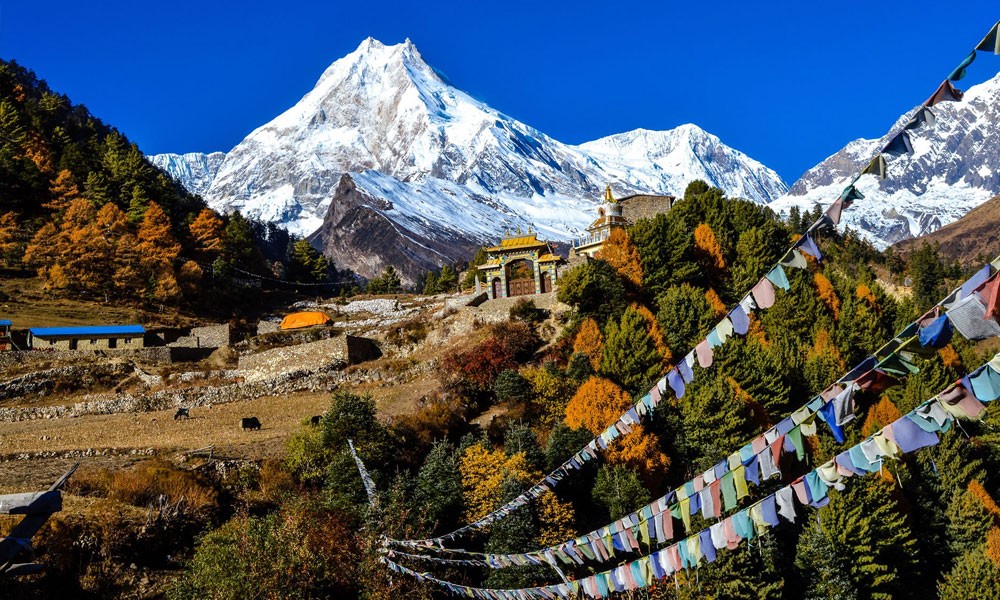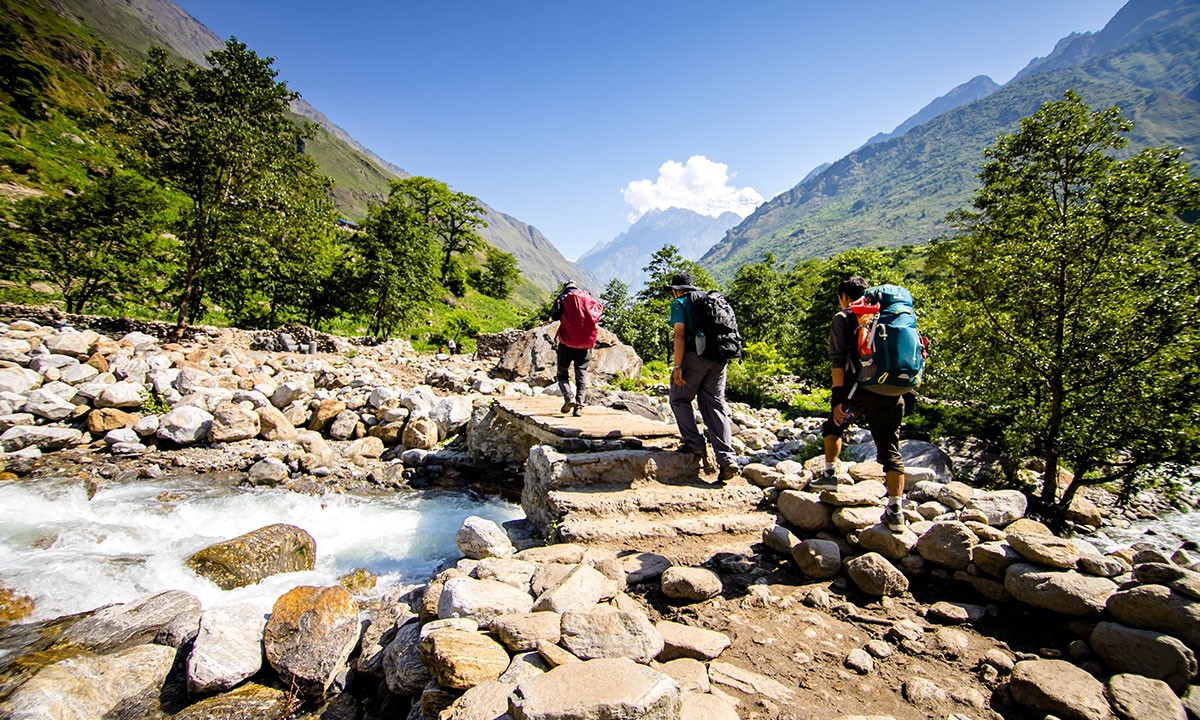What to Expect on Manaslu Circuit in December?

During your Manaslu Circuit in December, you can expect remarkable scenery in your winter exploration. Like any other season, your trek in December will start in the morning after morning breakfast at around 7 AM to 8 AM. You will enjoy a light and healthy breakfast and, of course, warm beverages before moving along the trekking route.
You will then spend about 4 hours on your trekking trail to reach your lunch destination. As the landscape of the Himalayas is challenging during this initial month of the winter season, it may take longer as you will trek slowly, minding your footing.
After reaching your lunch destination and enjoying the lavish, delightful delicacies, you will rest for a bit and then continue with your trekking route. In general, the trekking part after lunch is not that long. You will reach your designated destination in about 2 to 3 hours on average and slightly longer while navigating longer sections of the trail.
As the daylight hours of winter are pretty short, you may not get a chance to explore the region after reaching your destination. However, you will still have enough time to explore the region the next morning.
The dinner is typically served around 6 PM to 7 PM, and you will have enough time to chat with your buddies before bedtime. After dinner, you will also be briefed about the adventure taking place the next day so you can prepare for it efficiently.
I personally recommend getting enough sleep as it is important to replenish the lost energy. Lack of rest leads to exhaustion, which is linked to acute mountain sickness.
Physical Strength You Need for the Trek

Manaslu Circuit Trek is one of the most popular off-beaten trekking prospects in Nepal. This exciting wilderness exploration has been labeled as a moderately difficult Himalayan endeavor. You won’t have to take on any challenging technical section during this trek, nor will you have to do any strenuous climb as a mountain expedition. Still, you will cross a Himalayan pass Larke La Pass (5,106 meters) in this trek, so you will definitely need a good amount of endurance and stamina level.
Compared to other seasons, you will have to put some more effort into the training due to the weather challenges of this season. December, which is the initial period of the winter season, starts seeing snowfall and the higher altitudes. The trail will generally be covered in snow in the alpine zones, and the temperatures will also be freezing. So, it will be difficult to traverse across the snow-covered trails, and it will certainly be more physically demanding.
Similalrlly, due to the cold climatic conditions at the higher altitudes, it will be slightly challenging to acclimatize as well. Compared to other seasons, you will need to acclimatize more carefully during Manaslu Circuit in December. However, if you add some extra effort in your stamina and strength training considering these factors, you will be able to secure a comfortable and safer trek.
Why Manaslu Circuit in December?

Clear Sky and Himalaya Panorama
Yes, the winter is the coldest season in the Himalayas. The temperatures drop significantly and you will see occasional snowfalls as December is just the starting month of the winter season. However, the sky is mostly clear during these months, and days are often sunny and warm at the lower altitudes.
So, during your Manaslu Circuit in December, you will still be able to enjoy the epic panoramic views of the Himalayas during your trek. The Manaslu Trek generally unveils epic views of the magnificent Himalayan peaks like Manaslu, Annapurna, Himlachuli, Larke Peak, Cheo Himal, and other surrounding peaks.
During your trek, not only will you be able to enjoy wide Himalayan vistas of these peaks, but as the winter is the prime season of the Himalayas, you will also see the true grandeur of these peaks covered by snow.
Tranquil Experience
Compared to the high season, the number of trekkers is pretty low during the low season. The number of trekkers is even lower during the winter season as most trekkers prefer to avoid the cold climatic conditions. So, your Manaslu Circuit in December will ensure a tranquil experience in the most peaceful environment.
You will be able to immerse in your exploration without worrying about the crowd during your trek in December. As winter is the pinnacle point of the Himalayas, you will have the opportunity to relish the unique charm of the mystical mountains.
On top of that, the teahouses along the trekking trails are mostly empty and you don’t have to worry about your scheduled events. You will able to enjoy the services available at your own pace.
Winter Wonderland
Every season has a unique charm about it and shows a different side of the mountain depending on the season of the visit. Like how the spring season is famous for its incredible natural paradise, the winter season is known for its winter wonderland.
The entire landscape at the higher altitudes is covered by thick blanket of snow. Thus, during your Manaslu Circuit in December, you will see the snow-covered terrain as far as your eyes can reach. The magical landscapes covered by the snow fur offer a unique perspective on the beauty of the Himalayas.
It may not be colorful or bright like the spring, but the white-snow landscape tells the beautiful tale of the winter cycle. Every step you take will feel like you're getting closer to the heavenly realm, of course, figuratively.
Cultural Immersion
Nepal is known as the hub of incredible celebration. Beautiful festivals are celebrated in this diverse country throughout the year. Of course, the celebration doesn’t fall short when it comes to the winter season as well. During your Manaslu Circuit in December, you will be able to take part in vibrant festivals like Sitab Bibahan Panchami, Yomari Punhi, Ubhauli Parva, etc.
Even if they are not grand like the autumn season, they still add unique perspectives to your exploration. These festivals are celebrated by different ethnic groups, and you will be able to see the beauty of diversity during your Manaslu Circuit in December.
Easy to Find experienced guides and porters
Both winter and monsoon are the low seasons that don’t receive a large volume of trekkers from all around the world. If you have trekked in Nepal during the peak trekking points like autumn and spring, you then understand the queues of trekking groups setting to explore the Himalayas.
In such circumstances, it is hard to secure experienced guides and porters as the agencies have to handle the inflow of huge traffic. However, during the low seasons, as the number of trekkers slowly simmers down and reaches its lowest point in winter.
So, you will be able to secure experienced guides and porters during your Manaslu Circuit in December. You don’t have to worry about being led by the greenhorns who are new to the trekking world.
Unique Wildlife
Manaslu Circuit takes you across two of the most stunning conservation areas in the Himalayan region: Manaslu Conservation Area and Annapurna Conservation Area. Both of these protected areas are known for the rich bio-diversity of the Himalayan flora and fauna.
As most animals hibernate during the winter season, you will be able to see the more active endangered wildlife in the region, like Snow Leopards, Red Pandas, Himalayan Tahr, Himalayan Marmot, Himalayan Monal, etc. So, you can expect the journey to be a wonderful opportunity to admire active wildlife adapting to the freezing cycle of nature.
Snow Sports
When there is snow, it certainly gives an opportunity to relish the exciting snow sports. Your Manaslu Circuit in December will really be an exhilarating odyssey to every bit of the charms of the peak period of the Himalayas.
Besides the amicable natural and cultural experience, during your December trek, you will also have to enjoy some of the incredible snow sports to add thrills to your journey. Skiing, snowboarding, ice skating, etc, are some remarkable winter sports that you can indulge in during your Himalayan exploration.
How You Should Prepare?

As we discussed earlier, the Manaslu trek in November is somewhat of a more physically demanding journey, and you will need to make an adequate amount of preparation. The standard recommended period for the preparation to trek in the Himalayas is approximately 3 to 6 weeks. However, depending on your physical capabilities, you can adjust the period as you see fit.
If you are in a good shape, then you may not have to put in a lot of hours to trek for your Manaslu Trek. However, if you are barely physically active, then you need to consider training more efficiently or extending your training period.
The major part of your focus should be on developing your strength and endurance level. These exercises will help you over the physical demands of the trek, where you will have to navigate across the rugged and snow-covered landscapes carrying your backpack.
The stamina and cardiovascular exercises extend your stamina reserve and also improve your body's overall oxygen-handling capabilities. It means you will be able to acclimatize more easily as you ascend to higher altitudes during your wilderness exploration.
Strength and Endurance Exercises
- Bicep Curl
- Plank
- Push Up
- Pull Up
- Deadlift
- Dip
- Bench Press
- Upright Row
- Later Raise
- Leg Curl
- Leg Press
- Step Up
- Lateral Raise
- Dip
Stamina and Cardiovascular Exercises
- Jogging
- Cycling
- Dancing
- Kickboxing
- Swimming
- Mountain Climber
- Skipping Rope
Note: Practise hikes and stair climbing are also the most effective exercises to understand and overcome the mountain terrains.
You may also like:
Permit for Manaslu Trek in December

The reason why Manaslu Circuit is one of the most popular off-beaten trekking adventures in the Himalayas is due to the fact that it explores major trekking destinations in the country. First, this circuit trek route takes you across the isolated wilderness of the west central Himalayas, then, during the ending part, brings you to the mainstream Annapurna region.
That's why the permit requirement for this trek is slightly longer than that for other explorations. You will need to collect the following permits to take part in this exciting Himalayan odyssey.
Required Permit
- Manaslu Conservation Area Permit
- Annapurna Conservation Area Permit
- Manaslu Restricted Area Permit
Both of the conservation areas permit give access to the Himalayan protected areas of their respective region. The costs for these permits are also pretty much similar; both Manaslu Conservation Area Permit and the Annapurna Conservation Area Permit cost about US$ 30 per person regardless of the season.
However, as for the Manaslu Resticted Area Permit, the cost structure differs depening on the season of visit. If you are doing this trek in the autumn season, you will have to pay US$ 100 per person for this permit. For other seasons i.e. winter, monsoon and spring, the cost of this permit is about US$ 75 per person.
Guide and Porter

Guide and porters are very crucial for any high altitude and remote exploration. It is a risk-free way of enjoying your exciting journey. As during your Manaslu Circuit in December, you will have to traverse across the winter landscapes of the Himalayas and protect yourself from the challenging weather, guide, and porter are without as doubt, an absolute necessity.
Also, it is not possible to trek in Nepal at high altitudes without hiring a government-licensed guide. Guides add value to your experience and provide details about the region as you move along your trekking route. They also take care of handling food, accommodation, and permits, so you can trek without worrying about anything.
Besides that, these skilled personnel are also responsible for your well-being and your comfort level. They will monitor your health conditions every day and check how comfortable you are with your journey. As for the porters, these helpful professionals assist you with your luggage.
It is not possible to trek for long hours carrying heavy luggage, and by doing so, you will also not be able to actually enjoy your adventure as you will be exhausted most of the time. So, these helpful porters will assist you with your luggage so you can travel light and enjoy your Himalayan journey.
The guide-to-porter ratio is 2:1; one porter is assigned for every two trekkers. The porter will carry an approximate weight limit of 15 kg per trekker and if your luggage exceeds the mentioned weight limit, you will have to carry the luggage by yourself or hire an additional porter at an extra cost.
Note: The cost of a guide in the Manaslu Circuit route is around US$ 30 to US$ 35 per day, and as for the porter, the general cost margin is about US$ 25 to US$ 30 per day. Marvel Adventure's trek packages include guides and porters free of cost.
Packing List for December
.jpg)
December is the initial month of the winter season. Although this isn't the core period of the winter season, the weather is still freezing in this season. So, to tackle the weather challenges and keep yourself warm during your Manaslu Circuit in December, you will need to pack the warm layers.
Also, packing the useful gear will also make the experience more comfortable. Still, you don't want to go overboard with the packing as the maximum weight limit per trekker for the porter is about 15kg. So, you should consider optimizing your packing list and arranging the packing list according to their priority.
You can use our following pack list suggestion as a reference to organize your packing.
For Head and Body
- Sun hat
- Neck scarf, cowl, or gaiter
- Warm gloves and mittens
- Warm base layers
- Thermals and vest
- Sweater or sweatshirt
- Warm fleece jacket
- Windproof warm jacket
- Insulated fur jacket
- Heavy down jacket
- Comfortable and warm trousers
- Heavy Woolen trousers
- Warm undergarments
For Feet
- Warm pair of socks
- Insulated socks
- Insulated trekking boot
- Warm sport shoes
- Crocks
- Feet gaiter
Personal Hygiene/Toileries
- Toothbrush and toothpaste
- Bar soap and shampoo
- Body lotion and lip care
- Sunscreen cream
- Toilet paper
- Tissue paper
- Small mirror and comb
- Razor
- Body spray and perfume
- Hand sanitizer
- Personal medication
- First aid box
- Water filtration system
- Female hygiene products
Equipment
- Sleeping bag for minus degrees
- Trekking poles
- Crampons (optional)
- Backpack
- Binoculars
- Maps and GPS
- Portable heater
- Powerbank
- Thermos flask
- Headlamp
- Duct tape
- Multi-tool knife
- Whistle
- Book and journal
Note: Remember to pack high-energy snacks and energy bars for your trek in December. You should buy the required volume of products in Kathmandu, as it can be costly in the mountains, and you may not always find what you are looking for.
Travel Insurance

For any kind of high-altitude trek in Nepal, you will need to get travel insurance. You won’t be able to trek in Nepal without insurance; you will be requested a copy of your insurance even while getting the permits necessary for the trek. Getting travel insurance is beneficial in the long run, and you won't have to bear the financial burden all by yourself in case of any emergencies.
Getting travel insurance is not that expensive either; you can get general travel insurance with insurance coverage upto 3,000 meters at just US$ 30 to US$ 50. For the recommended up to 6,000 meters coverage of, the cost of the insurance will be around US$ 100 to US$ 150.
In case you are planning to get an insurance plan with helicopter rescue coverage, the cost can range over US$ 1,000. But, if you are unable to continue with your trekking route, the helicopter rescue will return you all the way back to Kathmandu.
Note: The travel insurance plan will vary depending on the age of the person as well. The insurance package that costs US$ 50 for the trekkers upto 39 years can cost US$ 150 for the trekkers in their 60s.










.jpg)







